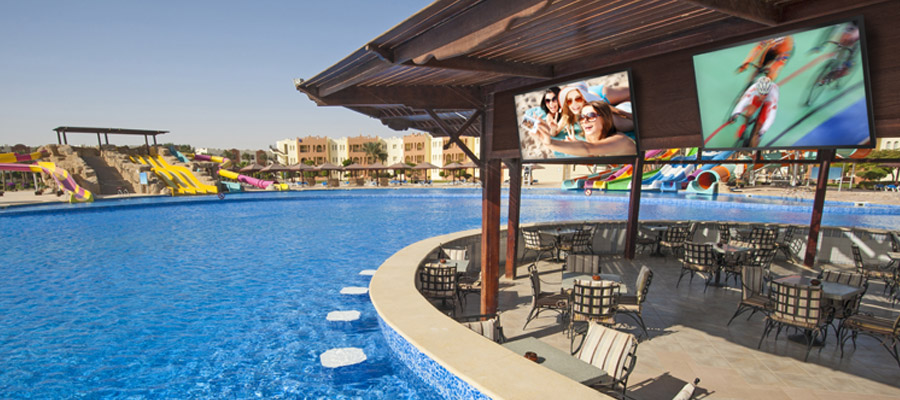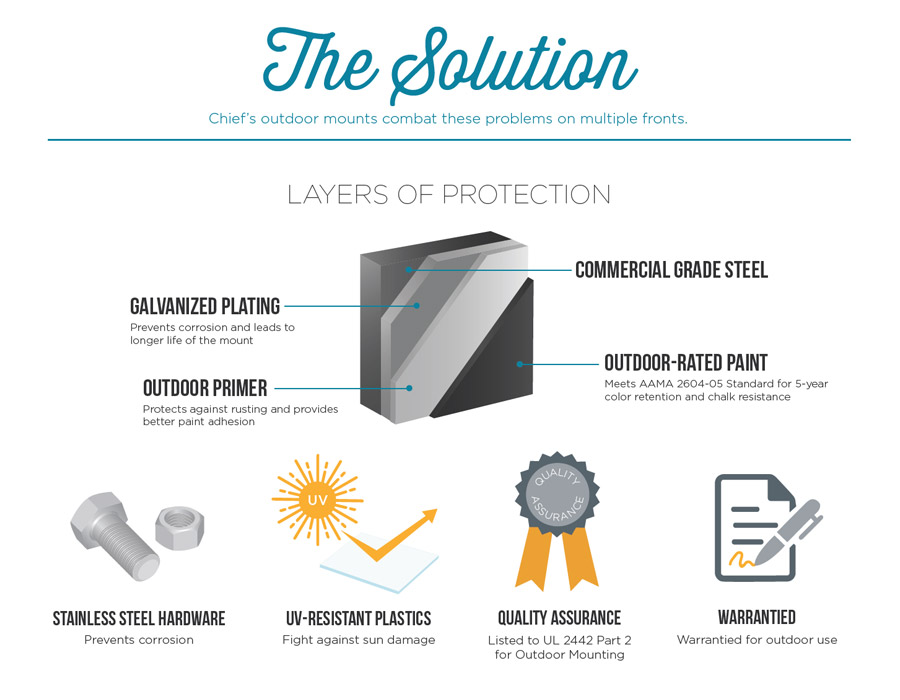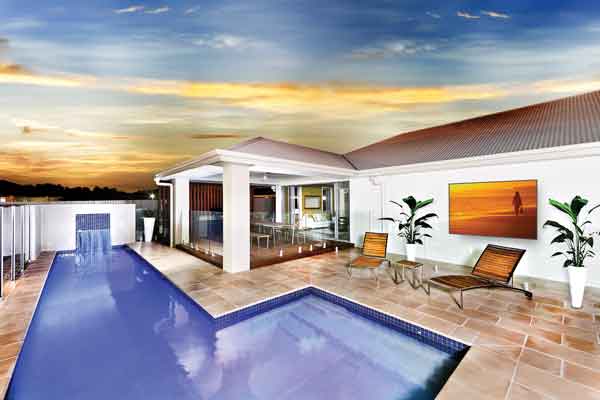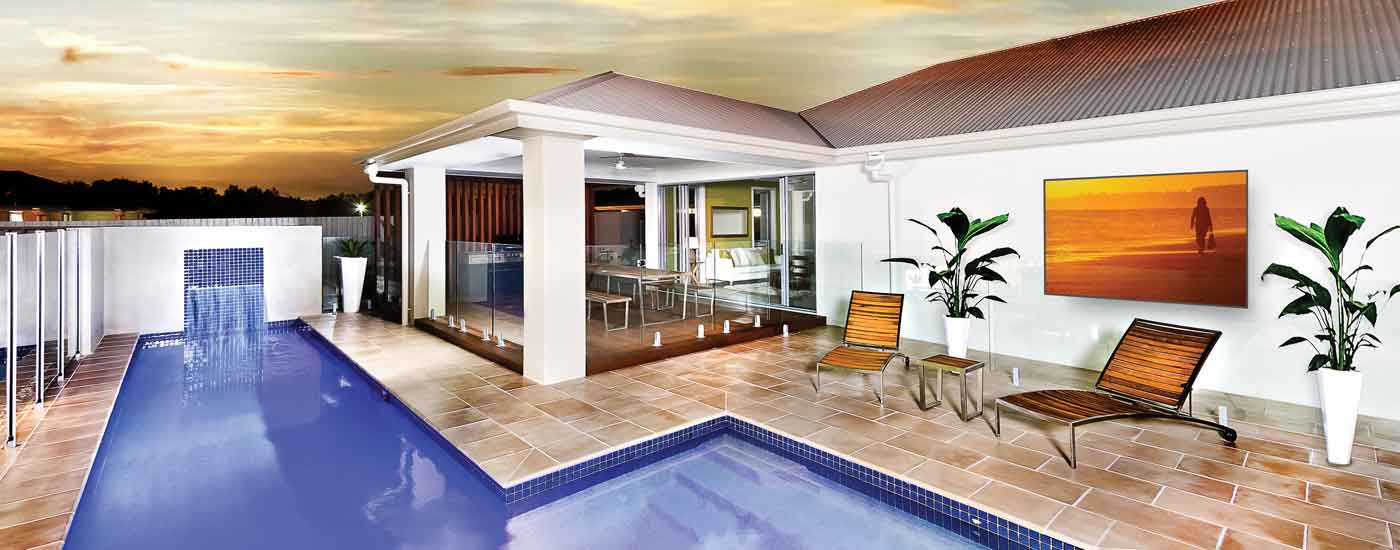Improving Aesthetics and Increasing Longevity with Outdoor Rated Mounts
However, the mount is often an afterthought in these applications, and this can be a mistake both for aesthetics and longevity of the installation.
- - - - - -
Executive Summary
Display use in outdoor environments is a rapidly growing segment of the market, whether for outdoor digital signage or outdoor hospitality and living spaces. The advent of displays that perform in a wide range of weather conditions has brought about increased use of the technology for outdoor stadiums, amusement parks and transportation as well as residential spaces. Specialized displays that can withstand sun, rain and snow are increasingly common, as is the use of traditional displays in semi-enclosed outdoor environments where direct exposure to the elements isn’t a problem. However, the mount is often an afterthought in these applications, and this can be a mistake both for aesthetics and longevity of the installation.
Industry Challenge
Technology advances have created new opportunities for AV integration outdoors. Stadiums use menu boards and displays throughout the facilities to create a better experience for guests. Displays are used at outdoor transportation stops to inform passengers on wait times and routes as well as additional advertising revenue streams. Amusement parks, zoos and other outdoor parks rely on digital displays for outdoor wayfinding, menu boards and in-line communication and entertainment. Residential outdoor displays help create living spaces that bring the inside outside, so you can watch the game on the patio while grilling on a nice day. Commercial end users are shifting to digital signage for the benefits of modern marketing tools and better customer experiences.However, outdoor AV creates new problems, particularly when the mount is not considered. While outdoor-rated displays can withstand exposure to rain, humidity, wind and UV radiation, if the mount is not specially built to handle these same issues, problems arise.

A mount that isn’t outdoor rated can begin to rust over time. This can cause aesthetic issues like rust staining the wall and floor underneath the mount. Additionally, standard mounts are not rated for UV exposure, which can lead to ugly paint chalking, and faded, brittle plastics. When displays are ceiling or pedestal mounted, they can act like sails, catching the wind and damaging property.
Solution
Outdoor rated mounts are designed to withstand the long-term effects of sun, rain, ocean air and humidity to maintain a safe installation while retaining the intended aesthetics. Ceiling and pedestal mounts should also be engineered to avoid catastrophic failure in a high-speed wind event. Let’s take a closer look at each of these challenges and how proper mount design addresses them.
Rain/Humidity/Ocean Air
Moisture over time causes rust, both weakening the mount as well as raising the potential for building damage if the rust washes down onto the structure.Weather-proofing a mount with many surfaces and connection points takes careful planning and design.
Every piece of sheet metal used in the mount is surrounded with galvanized plating, outdoor primer and outdoor-rated paint to resist oxidation.
Galvanized steel has a thin zinc coat that increases the life of the base metal by sacrificing itself to the corrosion process instead of the steel. Primers can also add cathodic protection, particularly when drill holes and cut edges go through the galvanized plating to expose the underlying metal.
The American Architectural Manufacturers Association (AAMA) provides guidelines for coatings used in outdoor applications. AAMA 2604-05 standards help architects and others specify manufacturer applied coatings designed for outdoor use. Primers help with adhesion of the AAMA 2604-05 coating, as well as provide additional protections to the parts of the mount the galvanized plating does not cover. This also creates a thicker layer of protection (175-200 microns thick) for longer life and better resistance to marring when compared to 15-30 micron thick electrocoating processes.
Minimizing or eliminating weld points, and priming & painting over the necessary welds, provides the best outdoor performance.
- - - - - -
Hardware is another point of consideration. Non-outdoor rated hardware can be a major rust point, leading to significant staining of architecture over time. Using stainless steel hardware eliminates such rust points, ensuring the installation won’t detract from the environment over time.

UL 2442 Part 2 “Outdoor Mounting Systems,” prescribes certain requirements for a mounting system to be marked “Suitable for outdoor use.” These requirements include surfaces of metal to be protected from corrosion by coatings, use of outdoor paints, weld specifications and use of polymeric materials. Systems also must undergo rigorous testing to qualify for UL 2442 Part 2 listing.
Semi-Enclosed Outdoor Spaces
Many outdoor applications are in semi-enclosed environments, such as in a covered stadium concourse or under an awning, which protects the display and mount from direct exposure to most elements. In these types of applications, traditional indoor displays are often used without issue. However, long-term exposure to humid air can lead to rusting of the mount, which can cause aesthetic damage to the architecture and potential weakening of the mount. Thus, use of outdoor-rated mounts is highly recommended in any humid air environments, even if the mount won’t be directly exposed to rain or sunshine.
Indoor Humid Environments
Humid indoor environments also can benefit from an outdoor-rated mount due to similar issues with rusting. Consider specifying outdoor-rated mounts for locations such as humid indoor pool decks and gym bathrooms and locker rooms.
UV/Sun
Sun exposure over time can fade plastics and make them brittle. This is often seen in plastic patio furniture that cracks and breaks down over the years. Minimizing plastic, and using plastic compositions that can handle UV exposure increases outdoor life.
Sun exposure over time can fade plastics and make them brittle.
- - - - - -
AAMA 2604-05 standards ensure color retention and chalk resistance for five years4. AAMA 2604-05 coatings are at least 30 microns thick for commercial and architectural-grade applications.
Coatings are rigorously tested for adhesion, impact resistance, chemical resistance, corrosion, salt spray resistance and chalking to qualify for the AAMA 2604-05 standards.
Wind
Perhaps more than the other outdoor elements, wind can be especially difficult to tackle. For displays hanging from the ceiling or bolted to the ground, integrators need to factor in display size, column length, number of columns, surroundings, distance from the ground, elevation, topography and more in order to be confident an installation can handle the high wind speeds it may encounter. The larger the display and the longer the column, the more force that comes into play at the base.
To better understand, think of the display and column like a shovel. The larger the display (e.g. the heavier the load on the shovel blade) the harder it is to hold up. Likewise, the farther away ones’ hand is from the shovel blade, the harder it is to hold up.
Most displays, including outdoor displays, are not rated for wind exposure. This leaves them vulnerable to wind forces that come from behind the display. To combat this problem, a mount should either have another display behind it facing the opposite direction or a wind deflector should be put in place to bear the majority of the wind forces.
Beyond the display, outdoor columns can be designed to flex under extreme wind loads to protect the structure, yet rigid enough to provide a good user experiences on a breezy day. In theory, the column absorbs most of the force; preventing severe damage from being done to the structure.
In addition to wind readiness, look for mounts that are easy to install for one person, particularly someone on a scissor lift. The ability to put in lag bolts to assist in the installation helps keep the process safer and faster.
Conclusion
Displays used in outdoor spaces, or even humid indoor ones, need outdoor-rated mounts for a safe, aesthetic installation that will last for years. Through use of Chief outdoor-rated mounts, end users can be assured that the installation won’t cause rust issues or other aesthetic concerns as time goes by.Chief outdoor mounts use galvanized steel, outdoor primer and outdoor-rated paint to provide years of protection from UV radiation and moisture. UV-resistant plastics, minimized weld points and stainless steel hardware extend the weather protection throughout the mount. In addition to protecting the installation from damage, wind resistant mounts are tested for visual experience under stress.
Chief serves customers with digital signage rollouts from start to finish. From product phase recommendations, site surveys, pilot phase support and project management to product modifications and engineering assistance, Chief works as a trusted partner and consultant to provide the support and expertise needed at each step of development. Revit models are available to make mount specification easier.
- Related Products
- Resources
- Videos
Related Products
Resources
Product Downloads
Videos

Windbusters Put Chief Outdoor Display Mounts to the test


